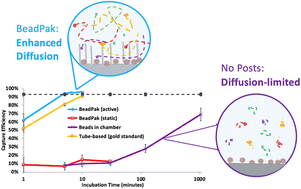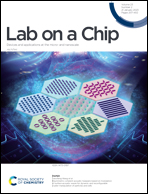A modular microfluidic device that uses magnetically actuatable microposts for enhanced magnetic bead-based workflows†
Abstract
Magnetic beads have been widely and successfully used for target enrichment in life science assays. There exists a large variety of commercially available magnetic beads functionalized for specific target capture, as well as options that enable simple surface modifications for custom applications. While magnetic beads are ideal for use in the macrofluidic context of typical laboratory workflows, their performance drops in microfluidic contexts, such as consumables for point-of-care diagnostics. A primary cause is the diffusion-limited analyte transport in these low Reynolds number environments. A new method, BeadPak, uses magnetically actuatable microposts to enhance analyte transport, improving yield of the desired targets. Critical parameters were defined for the operation of this technology and its performance characterized in canonical life-science assays. BeadPak achieved up to 1000× faster capture than a microfluidic chamber relying on diffusion alone, enabled a significant specimen concentration via volume reduction, and demonstrated compatibility with a range of biological specimens. The results shown in this work can be extended to other systems that utilize magnetic beads for target capture, concentration, and/or purification.



 Please wait while we load your content...
Please wait while we load your content...